July ’19
Carved Pith Temple
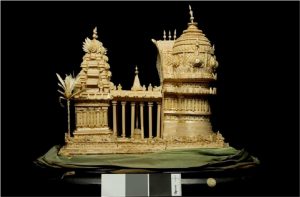
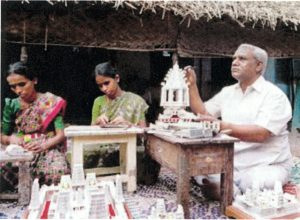
July’s ‘Object of the Month’ is a large model of a temple carved from pith wood, which is part of the Oriental Museum’s collection. The model is likely from the Rameswaram region in India and represents a religious temple. It’s made from carved sola pith, which comes from the sola plant (Aeschynomene aspera) Pith tends to be carved using a variety of knives, depending on the size of the pith samples and the extent of decoration required. All pieces of pith are carved separately and then adhered together; the entire model is made from pith with no other material being used to act as additional support.
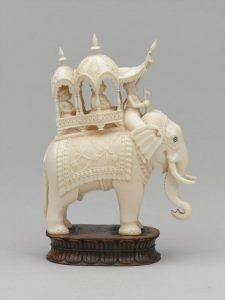
When new, sola pith is bright white and was used as it looked like ivory but was far cheaper and easier to acquire and work. Sola pith tends to darken and yellow over time, which then makes it distinguishable from ivory. Historically, pith was used to carve religious figures and traditional garlands. These types of models, which represented temples, started to appear in international exhibitions between 1873 and 1886.
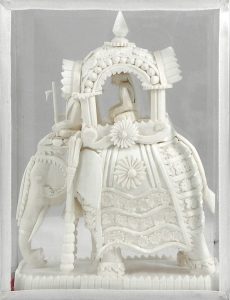
During the Victorian period, westerners became interested in acquiring decorative items for display in their homes from ‘exotic’ locations. This demand saw many objects being created for the tourist trade, including pith models.
Conservation
The ribbon around the base of the model was removed, gently flattened using a combination of humidity and weight and then rolled onto a tube with acid free tissue for storage alongside the object. As there was evidence of mould growth around the base of the model, this required treatment before any of the other areas of the model could be conserved. It was removed using a soft brush into an appropriate vacuum and the surface was then treated with a suitable solvent in order to kill any remaining mould spores.
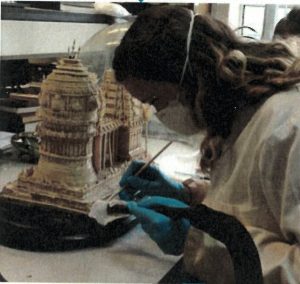

The model was fully surface cleaned using a combination of dry cleaning methods; a conservation grade material known as akapad was used on the accessible, flat areas such as the floor of the temple, while an alternative material was used on the more intricate areas that were less accessible.
There were a number of original fragments of pith which had become loose or detached and would require re-adhering. As there was no literature that focused on carved pith, in house testing was required in order to identify the most appropriate adhesive. New pith was ordered and cut into strips, which were then snapped in half. These strips were then adhered using a variety of suitable adhesives in order to determine which would be the most appropriate.


During the surface cleaning process it was found that as well as several areas of the model being loose or detached, there were also a number of losses to the model. As such, new pieces were carved from pith and colour matched to display a slightly aged appearance. These were then adhered into places where it was clear there was a loss using an appropriate adhesive. Areas where further support was required, for example the palm leaves, were backed using Japanese tissue in order to provide strength and stability.

It had also become clear during the initial surface clean that there were several areas of structural weakness, especially around the floor of the model. These areas were stabilised using a suitable filler, which was then colour matched in order to minimise obtrusiveness. This provided additional overall support for the structure.

Beneath the green fabric that covered the base, an original blue velvet was found in very good condition as it had been protected from light damage by the green ribbon. As the ribbon was not intended to be reattached to the object, and would instead be stored alongside it, the decision was made to create a cover to continue protecting the velvet. A dark grey fabric was chosen as this was fairly neutral, which was used to cover two sections of acid free card, cut to the size and shape of the base. By separating the cover into two pieces, there was minimal risk to the object as the cover could be slid into place from either side rather than placed over the top, which could risk damaging the pith model.
Stay tuned for next month’s object!
